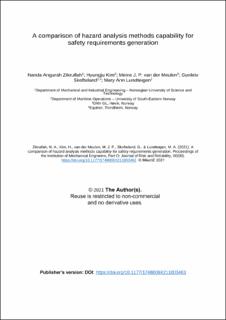A comparison of hazard analysis methods capability for safety requirements generation
Zikrullah, Nanda Anugrah; Kim, Hyungju; van der Meulen, Meine J. P.; Skofteland, Gunleiv; Lundteigen, Mary Ann
Journal article, Peer reviewed
Accepted version
Permanent lenke
https://hdl.handle.net/11250/2779123Utgivelsesdato
2021Metadata
Vis full innførselSamlinger
Originalversjon
Zikrullah, N. A., Kim, H., van der Meulen, M. J. P., Skofteland, G., & Lundteigen, M. A. (2021). A comparison of hazard analysis methods capability for safety requirements generation. Proceedings of the Institution of Mechanical Engineers, Part O: Journal of Risk and Reliability. https://doi.org/10.1177/1748006X211003463Sammendrag
A safety-critical system comprising several interacting and software-intensive systems must be carefully analyzed to detect whether new functional requirements are needed to ensure safety. This involves an analysis of the systemic properties of the system, which addresses the effect of the interaction between systems and system parts. The paper compares two hazard analysis methods, which are often considered well-suited for such software-intensive systems: the Functional Hazard Analysis (FHA) and Systems-Theoretic Process Analysis (STPA). The focus is on the selection and improvement of the best methods, based on the lesson learned from the comparison of FHA and STPA. The analyses cover the hazard analysis processes, systemic properties, and the criteria of requirements. The paper concludes that STPA is the better choice over FHA. Insights are obtained to align both STPA and FHA methods with the broader topic on risk management, that is, hazard analysis method improvement, cautionary thinking, uncertainty management, and resilience management.

